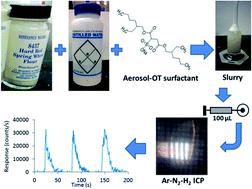当前位置:
X-MOL 学术
›
J. Anal. At. Spectrom.
›
论文详情
Our official English website, www.x-mol.net, welcomes your feedback! (Note: you will need to create a separate account there.)
Direct analysis of wheat flour by inductively coupled plasma mass spectrometry with flow injection, slurry nebulization, and a mixed-gas plasma
Journal of Analytical Atomic Spectrometry ( IF 3.4 ) Pub Date : 2020-09-02 , DOI: 10.1039/d0ja00275e Robert Teuma-Castelletti 1, 2, 3, 4 , Diane Beauchemin 1, 2, 3, 4
Journal of Analytical Atomic Spectrometry ( IF 3.4 ) Pub Date : 2020-09-02 , DOI: 10.1039/d0ja00275e Robert Teuma-Castelletti 1, 2, 3, 4 , Diane Beauchemin 1, 2, 3, 4
Affiliation

|
Inductively coupled plasma mass spectrometry (ICPMS) is well suited for vegetation analysis. Slurry nebulization offers an attractive alternative to traditional digestions that increase the risk of sample contamination and analyte loss. By simply grinding the sample very finely and suspending it in solution the material can be nebulized directly. While ICPMS has been used for slurry nebulization, it is susceptible to matrix effects. Mixed-gas plasmas have been shown to reduce or eliminate these matrix effects by increasing energy transfer between the bulk plasma and the central channel. This contribution uses flow injection and slurry nebulization for sample introduction into an Ar–N2–H2 mixed-gas plasma for analysis of wheat flour by ICPMS. 1% (m/v) aerosol–OT was used as a dispersing agent to stabilize the 1% (m/m) wheat flour slurry without additional grinding. To form the mixed-gas plasma, 462 mL min−1 of N2 gas was added to the 18.5 L min−1 Ar plasma flow. The normal Ar sheath gas was replaced with 4 mL min−1 H2 gas. External calibration without internal standardization was performed using aqueous standard solutions prepared in 1% (m/v) aerosol–OT. Accurate concentrations were determined for K, Fe, Zn, Cu, Mo, and Cd despite analysis being conducted in a 0.05% Na solution. Detection limits between 0.02 and 40 mg kg−1 of bulk sample were obtained. However, severe polyatomic interferences induced by the mixed-gas plasma prevented accurate determination of Al. Nonetheless, this method should be applicable to the analysis of any dried and finely ground plant material.
中文翻译:

流动注射,浆液雾化和混合气体等离子体的电感耦合等离子体质谱法直接分析小麦粉
电感耦合等离子体质谱法(ICPMS)非常适合植被分析。浆液雾化是传统消解的一种有吸引力的替代方法,传统消解增加了样品污染和分析物损失的风险。通过简单地非常细地研磨样品并将其悬浮在溶液中,可以直接将材料雾化。ICPMS已用于浆液雾化,但它易受基质效应的影响。已经显示出混合气体等离子体通过增加整体等离子体与中央通道之间的能量转移来减少或消除这些基质效应。该贡献使用流动注射和浆料雾化将样品引入Ar–N 2 –H 2中ICPMS用于分析小麦粉的混合气体等离子体。使用1%(m / v)的气溶胶-OT作为分散剂,以稳定1%(m / m)的小麦粉浆料,而无需另外研磨。为了形成混合气体等离子体,将462 mL min -1的N 2气体添加到18.5 L min -1的Ar等离子体流中。用4 mL min -1 H 2气体代替普通的Ar鞘气。使用在1%(m / v)气溶胶– OT中制备的标准水溶液进行没有内部标准化的外部校准。尽管在0.05%Na溶液中进行了分析,但仍确定了K,Fe,Zn,Cu,Mo和Cd的准确浓度。检出限为0.02至40 mg kg -1获得大量样品。然而,混合气体等离子体引起的严重的多原子干扰妨碍了Al的准确测定。但是,该方法应适用于任何干燥和精细研磨的植物材料的分析。
更新日期:2020-11-03
中文翻译:

流动注射,浆液雾化和混合气体等离子体的电感耦合等离子体质谱法直接分析小麦粉
电感耦合等离子体质谱法(ICPMS)非常适合植被分析。浆液雾化是传统消解的一种有吸引力的替代方法,传统消解增加了样品污染和分析物损失的风险。通过简单地非常细地研磨样品并将其悬浮在溶液中,可以直接将材料雾化。ICPMS已用于浆液雾化,但它易受基质效应的影响。已经显示出混合气体等离子体通过增加整体等离子体与中央通道之间的能量转移来减少或消除这些基质效应。该贡献使用流动注射和浆料雾化将样品引入Ar–N 2 –H 2中ICPMS用于分析小麦粉的混合气体等离子体。使用1%(m / v)的气溶胶-OT作为分散剂,以稳定1%(m / m)的小麦粉浆料,而无需另外研磨。为了形成混合气体等离子体,将462 mL min -1的N 2气体添加到18.5 L min -1的Ar等离子体流中。用4 mL min -1 H 2气体代替普通的Ar鞘气。使用在1%(m / v)气溶胶– OT中制备的标准水溶液进行没有内部标准化的外部校准。尽管在0.05%Na溶液中进行了分析,但仍确定了K,Fe,Zn,Cu,Mo和Cd的准确浓度。检出限为0.02至40 mg kg -1获得大量样品。然而,混合气体等离子体引起的严重的多原子干扰妨碍了Al的准确测定。但是,该方法应适用于任何干燥和精细研磨的植物材料的分析。



























 京公网安备 11010802027423号
京公网安备 11010802027423号